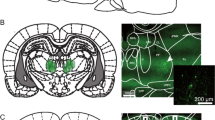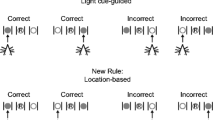Abstract
Rationale
Prefrontal cortex (PFC)-dependent executive function is disrupted in a range of psychiatric disorders and can be modelled in non-human primates and rodents using attentional set-shifting paradigms. There are few current pharmacological strategies for enhancing attentional set shifting, although the PFC is rich in relevant neurotransmitter targets, including 5-hydroxytryptamine (5-HT). Although 5-HT depletion studies do not support a role for 5-HT in attentional set shifting, the effect of 5-HT activation using specific receptor agonists has not been tested.
Objectives and methods
This study investigated the effect of a novel, selective 5-HT6 receptor agonist, WAY181187, in a rat model of PFC-dependent extra-dimensional (ED) attentional set shifting. The effect of this agent on immediate early gene expression in the medial PFC and other regions was also examined.
Results
Compared to vehicle-injected controls, WAY181187 facilitated ED set shifting but did not change other non-ED phases of the task (including intra-dimensional set shifting and reversal). This effect was blocked by the selective 5-HT6 antagonist SB399885, which alone had no effect. WAY181187 enhanced ED set shifting even when administered after the attentional set had been acquired, thereby ruling out impairments in attentional set formation. In separate experiments, at a dose that increased ED set shifting, WAY181187 increased Fos-like immunoreactivity in the medial PFC in a SB399885-sensitive manner, suggesting a 5-HT6 receptor-mediated activation of this region.
Conclusions
Through use of a novel 5-HT agonist, these experiments reveal a previously unrecognised role for 5-HT activation in PFC-dependent executive function, mediated by 5-HT6 receptor activation.





Similar content being viewed by others
References
Arnsten AF, Goldman-Rakic PS (1984) Selective prefrontal cortical projections to the region of the locus coeruleus and raphe nuclei in the rhesus monkey. Brain Res 306:9–18
Austin MP, Mitchell P, Goodwin GM (2001) Cognitive deficits in depression: possible implications for functional neuropathology. Br J Psychiatry 178:200–206
Birrell JM, Brown VJ (2000) Medial frontal cortex mediates perceptual attentional set shifting in the rat. J Neurosci 20:4320–4324
Bissonette GB, Martins GJ, Franz TM, Harper ES, Schoenbaum G, Powell EM (2008) Double dissociation of the effects of medial and orbital prefrontal cortical lesions on attentional and affective shifts in mice. J Neurosci 28:11124–11130
Boothman LJ, Sharp T (2005) A role for midbrain raphe gamma aminobutyric acid neurons in 5-hydroxytryptamine feedback control. NeuroReport 16:891–896
Boothman L, Raley J, Denk F, Hirani E, Sharp T (2006) In vivo evidence that 5-HT(2C) receptors inhibit 5-HT neuronal activity via a GABAergic mechanism. Br J Pharmacol 149:861–869
Clarke HF, Walker SC, Crofts HS, Dalley JW, Robbins TW, Roberts AC (2005) Prefrontal serotonin depletion affects reversal learning but not attentional set shifting. J Neurosci 25:532–538
de Foubert G, O'Neill MJ, Zetterstrom TS (2007) Acute onset by 5-HT(6)-receptor activation on rat brain brain-derived neurotrophic factor and activity-regulated cytoskeletal-associated protein mRNA expression. Neuroscience 147:778–785
Dias R, Robbins TW, Roberts AC (1996) Dissociation in prefrontal cortex of affective and attentional shifts. Nature 380:69–72
Floresco SB, Ghods-Sharifi S, Vexelman C, Magyar O (2006) Dissociable roles for the nucleus accumbens core and shell in regulating set shifting. J Neurosci 26:2449–2457
Fone KC (2008) An update on the role of the 5-hydroxytryptamine6 receptor in cognitive function. Neuropharmacology 55:1015–1022
Fox MT, Barense MD, Baxter MG (2003) Perceptual attentional set-shifting is impaired in rats with neurotoxic lesions of posterior parietal cortex. J Neurosci 23:676–681
Gerard C, Martres MP, Lefevre K, Miquel MC, Verge D, Lanfumey L, Doucet E, Hamon M, el Mestikawy S (1997) Immuno-localization of serotonin 5-HT6 receptor-like material in the rat central nervous system. Brain Res 746:207–219
Hajós M, Richards CD, Szekely AD, Sharp T (1998) An electrophysiological and neuroanatomical study of the medial prefrontal cortical projection to the midbrain raphe nuclei in the rat. Neuroscience 87:95–108
Hajós M, Gartside SE, Varga V, Sharp T (2003) In vivo inhibition of neuronal activity in the rat ventromedial prefrontal cortex by midbrain-raphe nuclei: role of 5-HT1A receptors. Neuropharmacology 45:72–81
Hatcher PD, Brown VJ, Tait DS, Bate S, Overend P, Hagan JJ, Jones DN (2005) 5-HT6 receptor antagonists improve performance in an attentional set shifting task in rats. Psychopharmacology (Berl) 181:253–259
Heal DJ, Smith SL, Fisas A, Codony X, Buschmann H (2008) Selective 5-HT6 receptor ligands: progress in the development of a novel pharmacological approach to the treatment of obesity and related metabolic disorders. Pharmacol Ther 117:207–231
Hirst WD, Stean TO, Rogers DC, Sunter D, Pugh P, Moss SF, Bromidge SM, Riley G, Smith DR, Bartlett S, Heidbreder CA, Atkins AR, Lacroix LP, Dawson LA, Foley AG, Regan CM, Upton N (2006) SB-399885 is a potent, selective 5-HT6 receptor antagonist with cognitive enhancing properties in aged rat water maze and novel object recognition models. Eur J Pharmacol 553:109–119
King MV, Sleight AJ, Woolley ML, Topham IA, Marsden CA, Fone KC (2004) 5-HT6 receptor antagonists reverse delay-dependent deficits in novel object discrimination by enhancing consolidation—an effect sensitive to NMDA receptor antagonism. Neuropharmacology 47:195–204
Konishi S, Kawazu M, Uchida I, Kikyo H, Asakura I, Miyashita Y (1999) Contribution of working memory to transient activation in human inferior prefrontal cortex during performance of the Wisconsin card sorting test. Cereb Cortex 9:745–753
Lewis SJ, Slabosz A, Robbins TW, Barker RA, Owen AM (2005) Dopaminergic basis for deficits in working memory but not attentional set-shifting in Parkinson's disease. Neuropsychologia 43:823–832
Lynch G (2004) AMPA receptor modulators as cognitive enhancers. Current Opinion in Pharmacology 4:4–11
Marder SR, Fenton W (2004) Measurement and treatment research to improve cognition in schizophrenia: NIMH MATRICS initiative to support the development of agents for improving cognition in schizophrenia. Schizophr Res 72:5–9
Nakahara K, Hayashi T, Konishi S, Miyashita Y (2002) Functional MRI of macaque monkeys performing a cognitive set-shifting task. Science 295:1532–1536
Oh MC, Derkach VA, Guire ES, Soderling TR (2006) Extrasynaptic membrane trafficking regulated by GluR1 serine 845 phosphorylation primes AMPA receptors for long-term potentiation. J Biol Chem 281:752–758
O'Hearn E, Molliver ME (1984) Organization of raphe-cortical projections in rat: a quantitative retrograde study. Brain Res Bull 13:709–726
Oswald CJ, Yee BK, Rawlins JN, Bannerman DB, Good M, Honey RC (2001) Involvement of the entorhinal cortex in a process of attentional modulation: evidence from a novel variant of an IDS/EDS procedure. Behav Neurosci 115:841–849
Paxinos G, Watson C (1997) The rat brain in stereotaxic coordinates, compact 3rd edn. Academic, New York
Porrino LJ, Goldman-Rakic PS (1982) Brainstem innervation of prefrontal and anterior cingulate cortex in the rhesus monkey revealed by retrograde transport of HRP. J Comp Neurol 205:63–76
Robbins TW, Roberts AC (2007) Differential regulation of fronto-executive function by the monoamines and acetylcholine. Cereb Cortex 17(Suppl 1):i151–i160
Schechter LE, Lin Q, Smith DL, Zhang G, Shan Q, Platt B, Brandt MR, Dawson LA, Cole D, Bernotas R, Robichaud A, Rosenzweig-Lipson S, Beyer CE (2008) Neuropharmacological profile of novel and selective 5-HT6 receptor agonists: WAY-181187 and WAY-208466. Neuropsychopharmacology 33:1323–1335
Stefani MR, Groth K, Moghaddam B (2003) Glutamate receptors in the rat medial prefrontal cortex regulate set-shifting ability. Behav Neurosci 117:728–737
Svenningsson P, Bateup H, Qi H, Takamiya K, Huganir RL, Spedding M, Roth BL, McEwen BS, Greengard P (2007a) Involvement of AMPA receptor phosphorylation in antidepressant actions with special reference to tianeptine. Eur J NeuroSci 26:3509–3517
Svenningsson P, Tzavara ET, Qi H, Carruthers R, Witkin JM, Nomikos GG, Greengard P (2007b) Biochemical and behavioral evidence for antidepressant-like effects of 5-HT6 receptor stimulation. J Neurosci 27:4201–4209
Talbot PS, Watson DR, Barrett SL, Cooper SJ (2006) Rapid tryptophan depletion improves decision-making cognition in healthy humans without affecting reversal learning or set shifting. Neuropsychopharmacology 31:1519–1525
Upton N, Chuang TT, Hunter AJ, Virley DJ (2008) 5-HT6 receptor antagonists as novel cognitive enhancing agents for Alzheimer's disease. Neurotherapeutics 5:458–469
Wesolowska A, Nikiforuk A (2007) Effects of the brain-penetrant and selective 5-HT6 receptor antagonist SB-399885 in animal models of anxiety and depression. Neuropharmacology 52:1274–1283
Woolley ML, Marsden CA, Fone KC (2004) 5-HT6 receptors. Curr Drug Targets CNS Neurol Disord 3:59–79
Acknowledgements
We acknowledge the support of a Medical Research Council Industrial Collaborative Studentship with GlaxoSmithKline (KB), a European Community Integrated Network (TS; NEWMOOD; LSHM-CT-2004-503474) and The Wellcome Trust (DMB; 074385).
Author information
Authors and Affiliations
Corresponding author
Rights and permissions
About this article
Cite this article
Burnham, K.E., Baxter, M.G., Bainton, J.R. et al. Activation of 5-HT6 receptors facilitates attentional set shifting. Psychopharmacology 208, 13–21 (2010). https://doi.org/10.1007/s00213-009-1701-6
Received:
Accepted:
Published:
Issue Date:
DOI: https://doi.org/10.1007/s00213-009-1701-6




